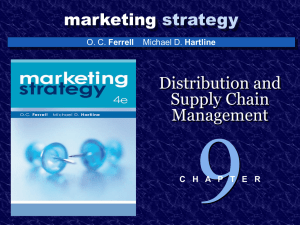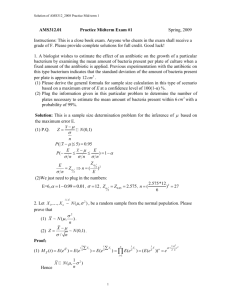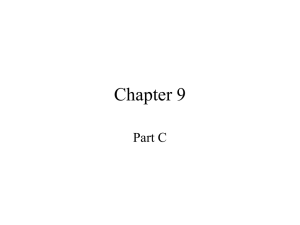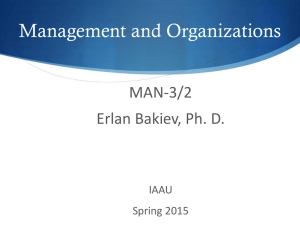ANSWER: b - Oklahoma City Community College
advertisement
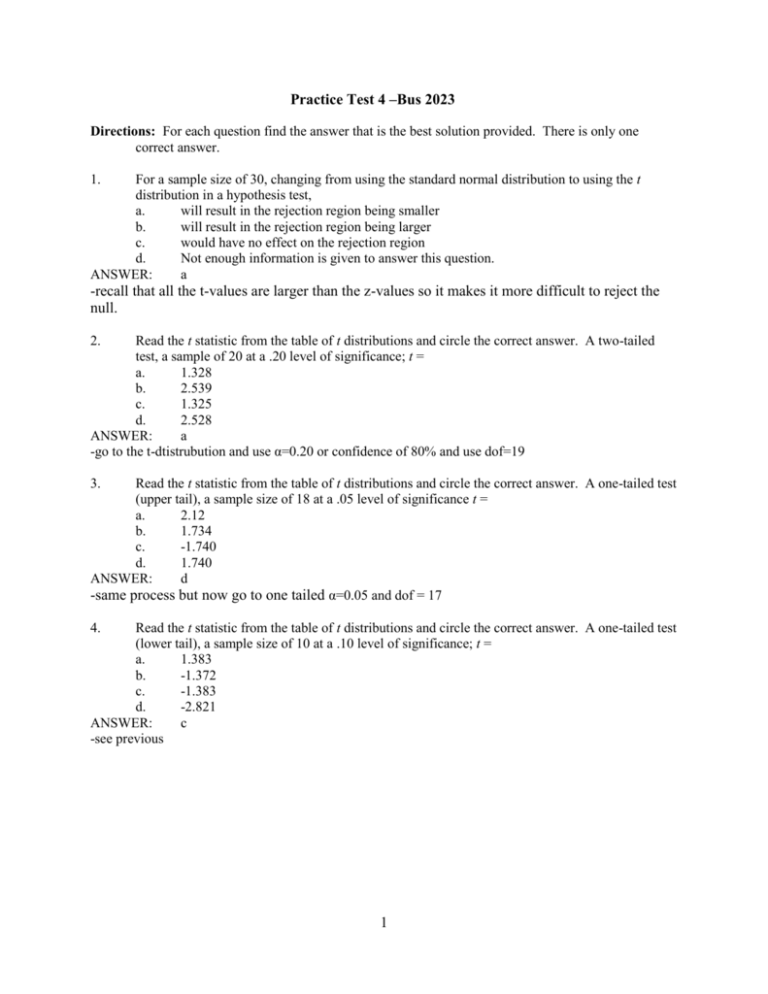
Practice Test 4 –Bus 2023 Directions: For each question find the answer that is the best solution provided. There is only one correct answer. 1. For a sample size of 30, changing from using the standard normal distribution to using the t distribution in a hypothesis test, a. will result in the rejection region being smaller b. will result in the rejection region being larger c. would have no effect on the rejection region d. Not enough information is given to answer this question. ANSWER: a -recall that all the t-values are larger than the z-values so it makes it more difficult to reject the null. 2. Read the t statistic from the table of t distributions and circle the correct answer. A two-tailed test, a sample of 20 at a .20 level of significance; t = a. 1.328 b. 2.539 c. 1.325 d. 2.528 ANSWER: a -go to the t-dtistrubution and use α=0.20 or confidence of 80% and use dof=19 3. Read the t statistic from the table of t distributions and circle the correct answer. A one-tailed test (upper tail), a sample size of 18 at a .05 level of significance t = a. 2.12 b. 1.734 c. -1.740 d. 1.740 ANSWER: d -same process but now go to one tailed α=0.05 and dof = 17 4. Read the t statistic from the table of t distributions and circle the correct answer. A one-tailed test (lower tail), a sample size of 10 at a .10 level of significance; t = a. 1.383 b. -1.372 c. -1.383 d. -2.821 ANSWER: c -see previous 1 Exhibit 9-4 A random sample of 16 students selected from the student body of a large university had an average age of 25 years and a standard deviation of 2 years. We want to determine if the average age of all the students at the university is significantly different from 24. Assume the distribution of the population of ages is normal. 5. Refer to Exhibit 9-4. The test statistic is a. 1.96 b. 2.00 c. 1.645 d. 0.05 ANSWER: b _ - Test Stat = ( x - μ) / (σ / n ) = (25-22) /(2 / 16 ) = 1 / 0.5 = 2 6. Refer to Exhibit 9-4. At a .05 level of significance, it can be concluded that the mean age is a. not significantly different from 24 b. significantly different from 24 c. significantly less than 24 d. significantly less than 25 ANSWER: a Exhibit 9-5 n = 16 x = 75.607 H0: 80 Ha: < 80 s = 8.246 Assume population is normally distributed. 7. Refer to Exhibit 9-5. The test statistic equals a. -2.131 b. -0.53 c. 0.53 d. 2.131 ANSWER: a _ - Test Stat = ( x - μ) / (s / n ) = (75.607-80) /(8.246 / 16 ) = -2.131 8. Refer to Exhibit 9-5. The p-value is equal to a. -0.025 b. 0.05 c. 0.525 d. 0.025 ANSWER: d -Recall that σ is unknown and the sample size is 15, so use the p-value for the t-distribution. This gives us a 1-Tailed p-value of 0.025. Note the dof = 15 9. Refer to Exhibit 9-5. If the test is done at a 1% level of significance, the null hypothesis should a. not be rejected b. be rejected c. Not enough information is given to answer this question. d. None of the other answers are correct. 2 ANSWER: a -since p-value =0.025 > 0.01 = α, then we fail to reject the null and conclude that the mean is not less than 80. 10. In the past, 75% of the tourists who visited Chattanooga went to see Rock City. The management of Rock City recently undertook an extensive promotional campaign. They are interested in determining whether the promotional campaign actually increased the proportion of tourists visiting Rock City. The correct set of hypotheses is a. H0: p > 0.75 Ha: p 0.75 b. H0: p < 0.75 Ha: p 0.75 c. H0: p 0.75 Ha: p < 0.75 d. H0: p 0.75 Ha: p > 0.75 ANSWER: d 11. The academic planner of a university thinks that at least 35% of the entire student body attends summer school. The correct set of hypotheses to test his belief is a. H0: p > 0.35 Ha: p 0.35 b. H0: p 0.35 Ha: p > 0.35 c. H0: p 0.35 Ha: p < 0.35 d. H0: p > 0.35 Ha: p 0.35 ANSWER: b Exhibit 9-6 A random sample of 100 people was taken. Eighty of the people in the sample favored Candidate A. We are interested in determining whether or not the proportion of the population in favor of Candidate A is significantly more than 75%. 12. Refer to Exhibit 9-6. The test statistic is a. 0.80 b. 0.05 c. 1.25 d. 2.00 ANSWER: NONE OF THE ABOVE ARE CORRECT -Z= = )/ where = = 0.0433 So Z = ) /0.0433 = 1.1547 13. Refer to Exhibit 9-6. The p-value is a. 0.2112 b. 0.05 c. 0.025 d. 0.1056 ANSWER: NONE ARE CORRECT SINCE THE P-VALUE OF 1.1547 IS 0.1251 3 14. Refer to Exhibit 9-6. At a .05 level of significance, it can be concluded that the proportion of the population in favor of candidate A is a. significantly greater than 75% b. not significantly greater than 75% c. significantly greater than 80% d. not significantly greater than 80% ANSWER: b -since the p-value = 0.1251 > 0.05 then we fail to reject Ho. 15. If two independent large samples are taken from two populations, the sampling distribution of the difference between the two sample means a. can be approximated by a Poisson distribution b. will have a variance of one c. can be approximated by a normal distribution d. will have a mean of one ANSWER: 16. c Independent simple random samples are taken to test the difference between the means of two populations. The sample sizes are n1 = 32 and n2 = 40. The sampling distribution of ( x 1 - x 2 ) is the a. normal distribution b. t distribution with 72 degrees of freedom c. t distribution with 70 degrees of freedom d. Not enough information given ANSWER: a -note that value of both n1 and n2 are greater than 30, so by CLT we can use the normal. 17. Independent simple random samples are taken to test the difference between the means of two populations. The sample sizes are n1 = 25 and n2 = 35. It is assumed that the variances of the populations are equal and that the populations are normally distributed. The sampling distribution of ( x 1 - x 2 ) is the a. normal distribution b. t distribution with 60 degrees of freedom c. t distribution with 58 degrees of freedom d. Not enough information given. ANSWER: c -in this case we have n1 < 30…so we use the t-distribution. Exhibit 10-1 The management of a department store is interested in estimating the difference between the mean credit purchases of customers using the store's credit card versus those customers using a national major credit card. Independent samples of credit sales are shown below. Sample size Sample mean Store's Card 64 $140 Major Credit Card 49 $125 4 Sample standard deviation 18. $ 10 $ 8 Refer to Exhibit 10-1. A point estimate for the difference between the mean purchases of the users of the two credit cards is a. 2 b. 18 c. 265 d. 15 ANSWER: d -simply take the difference between the two values (140 – 125 = 15) 19. Refer to Exhibit 10-1. A 95% confidence interval estimate for the difference between the average purchases of the customers using the two different credit cards is a. 49 to 64 b. 11.69 to 18.31 c. 125 to 140 d. 8 to 10 ANSWER: b Recall: ( ) ± zα/2 = 15 ± 1.96 = 15 ± 3.31 Exhibit 10-2 In order to determine whether or not there is a significant difference between the hourly wages of two companies, the following data have been accumulated. Company A Sample size 80 Sample mean $6.75 Sample standard deviation $1.00 Company B 60 $6.25 $0.95 20. Refer to Exhibit 10-2. A point estimate for the difference between the two sample means is a. 20 b. 0.50 c. 0.25 d. 1.00 ANSWER: b -same procedure as in 18 21. Refer to Exhibit 10-2. The test statistic is a. 0.098 b. 1.645 c. 2.75 d. 3.01 ANSWER: d Z= So Z = where SE = = =0.166 = 3.01 5 22. Refer to Exhibit 10-2. The null hypothesis a. is rejected b. not rejected c. Not enough information is provided to answer this question. d. None of the other answers is correct. ANSWER: c -Recall that we need α in order to tell this. Exhibit 10-4 A statistics teacher wants to see if there is any difference in the abilities of students enrolled in statistics today and those enrolled five years ago. A sample of final examination scores from students enrolled today and from students enrolled five years ago was taken. You are given the following results. Mean Variance Sample Size Today 82 112.5 45 Five Years Ago 88 54 36 23. Refer to Exhibit 10-4. The point estimate for the difference between the means of the two populations is a. 58.5 b. 9 c. -9 d. -6 ANSWER: d -same procedure as in 18 82- 88 = -6 24. Refer to Exhibit 10-4. The point estimate for the standard deviation of the difference between the means of the two populations is a. 12.9 b. 9.3 c. 4 d. 2 ANSWER: d SE = =2 25. Refer to Exhibit 10-4. The 95% confidence interval for the difference between the two population means is a. -9.92 to -2.08 b. -3.92 to 3.92 c. -13.84 to 1.84 d. -24.228 to 12.23 ANSWER: a Recall: ( ) ± zα/2 = -6 ± 1.96 = -6 ± 3.92 = -9.92 to -2.08 6 Short Answer Problems: 1. From a population of cans of coffee marked "12 ounces," a sample of 25 cans is selected and the contents of each can are weighed. The sample revealed a mean of 11.8 ounces with a standard deviation of 0.5 ounces. Test to see if the mean of the population is at least 12 ounces. (Assume the population is normally distributed.) Use a .05 level of significance. ANSWER: (1) H0: 12 Ha: < 12 -this is because we are testing to see if it is less than. _ (2) Test Stat: t = ( x - μ) / (s / n ) = (11.8- 12) / (0.5 / 25 ) = -0.2 / 0.1= -2; (3) Conclusion: We know the critical value for t is -1.711. Since -2 < -1.711 we reject Ho. Note that the dof is 24. Therefore, reject H0, there is sufficient evidence at = .05 to conclude that the population mean amount of coffee is less than 12 ounces. 2. In the past the average age of employees of a large corporation has been 40 years. Recently, the company has been hiring older individuals. In order to determine whether there has been an increase in the average age of all the employees, a sample of 25 employees was selected. The average age in the sample was 45 years with a standard deviation of 5 years. Assume the distribution of the population is normal. Let = .05. a. State the null and the alternative hypotheses. b. Test to determine whether or not the mean age of all employees is significantly more than 40 years. ANSWERS: a. H0: 40 Ha: > 40 -this is because we are testing to see if the age is greater. _ b. Test Stat: t = ( x - μ) / (s / n ) = (45- 40) / (5 / 25 ) = 5 / 1= 5; Conclusion: We know the critical value for t is now 1.711. Since 5 > > 1.711 we reject Ho. Note that the dof is 24. therefore, reject H0, there is sufficient evidence at = .05 to conclude that average age of all employees of the large corporation has increased 7 3. A sample of 16 cookies is taken to test the claim that each cookie contains at least 9 chocolate chips. The average number of chocolate chips per cookie in the sample was 7.875 with a standard deviation of 1. a. State the null and alternative hypotheses. b. Using a critical value, test the hypothesis at the 1% level of significance. c. Using a p-value, test the hypothesis at the 1% level of significance. d. Compute the probability of a Type II error if the true number of chocolate chips per cookie is 8. ANSWERS: a. H0: 9 Ha: < 9 _ b. Test Stat: t = ( x - μ) / (s / n ) = (7.875- 9) / (1 / 16 ) = 1.125 / 0.25= 4.5 Conclusion: Reject H0, -4.5 < 2.602 c. Reject H0; the p-value is less than 0.005. We don’t know the exact p-value because we are using a t-stat. But from the t-table we know that it is < 0.005. We know this because in the row with dof = 15 the larger value of t given is 4.073 and our test stat is even bigger than this. This is at the 99.9% confidence level, so α = 0.001, but since our test is one sided we only take half of this value. d. A Type II error has not been committed since H0 was rejected. 4. Consider the following hypothesis test: Ho: p = 0.5 Ha: p 0.5 A sample of 800 provided a sample proportion of 0.58. a. Using = 0.05, what is the rejection rule? b. Determine the standard error of the proportion. c. Compute the value of the test statistic z. What is your conclusion? d. Determine the p-value. ANSWERS: a. Reject H0 if z < -1.96 or if z > 1.96 b. c. d. = = 0.01767 Z= ) / 0.1767 = 4.53; Since 4.53 > > 1.96 reject H0, there is sufficient evidence at = .05 to conclude that the population proportion is significantly different from 0.5 It is about zero. The P ( Z > 4.53) is not even on our z-table since it is so small. It is roughly < 0.004 (note we multiply our lowest p-value of -3.49 by 2 since it a two tailed test to get this) 8 5. A new soft drink is being market tested. A sample of 400 individuals participated in the taste test and 80 indicated they like the taste. a. At a 5% significance level, test to determine if at least 22% of the population will like the new soft drink. b. Determine the p-value. ANSWERS: a. H0: p 0.22 Ha: p < 0.22 = b. 6. = 0.0207 Z= ) / 0.0207 = -0.97; therefore, do not reject H0, there is not sufficient evidence at = 5% to conclude that fewer than 22% of the population like the new soft drink P ( Z < -1 ) = 0.1660 -since it is only one tailed we don’t have to multiply the value by 2. The business manager of a local health clinic is interested in estimating the difference between the fees for extended office visits in her center and the fees of a newly opened group practice. She gathered the following information regarding the two offices. Sample size Sample mean Standard deviation Health Clinic 50 visits $21 $2.75 Group Practice 45 visits $19 $3.00 Develop an interval estimate for the difference between the average fees of the two offices. Use a confidence coefficient of 0.95. ANSWER: SE Recall: ( = ) ± zα/2 = 0.593 = 2 ± 1.96 = 2 ± 1.162 = 0.838 to 3.162 So we are 95% confident the true population mean lies within 0.838 and 3.162 9




